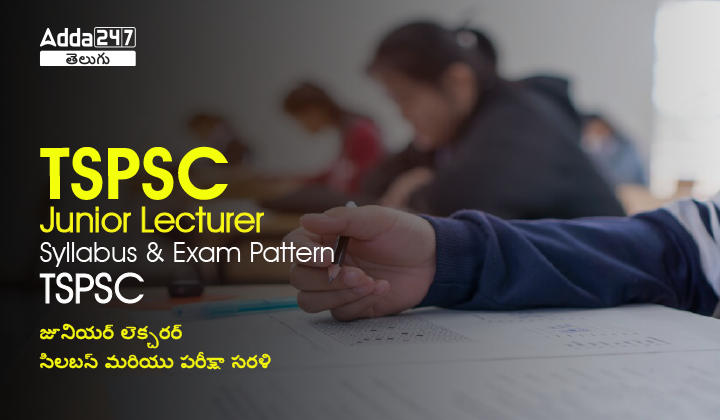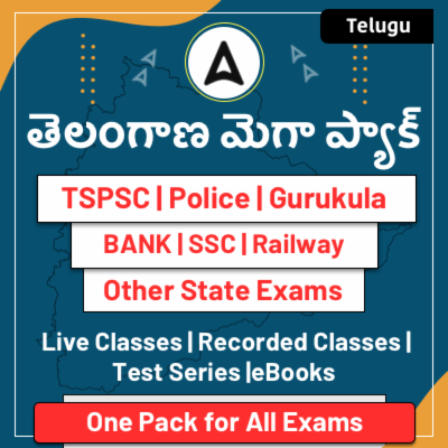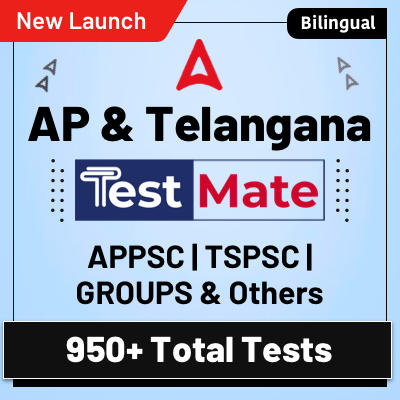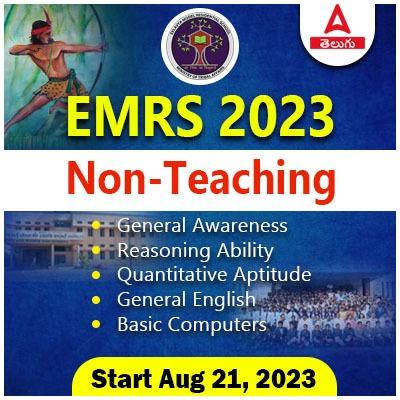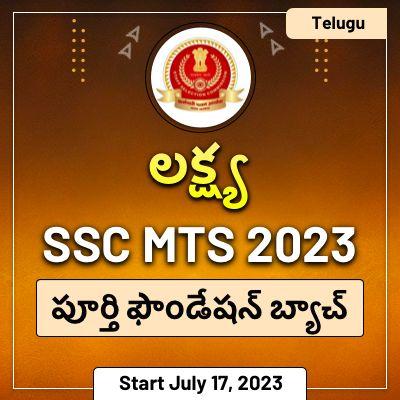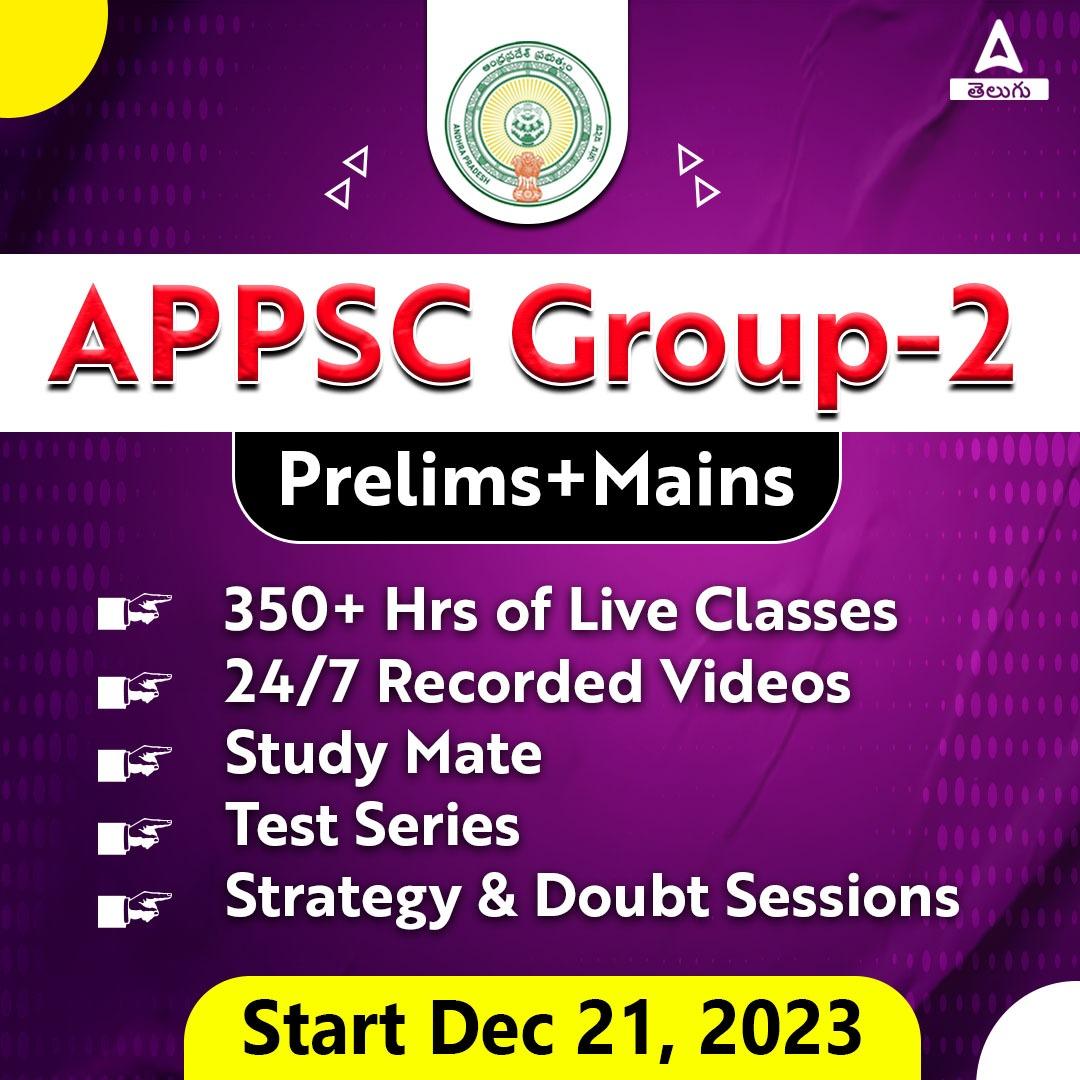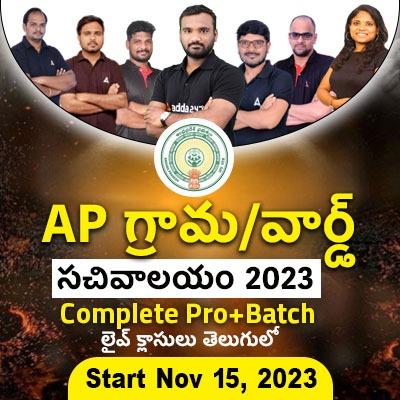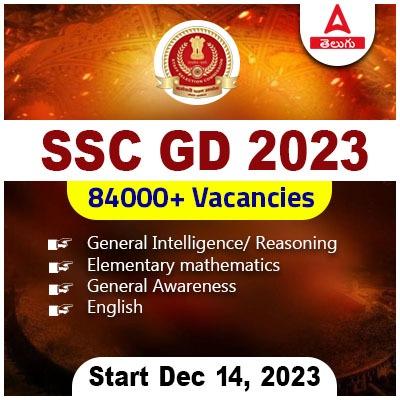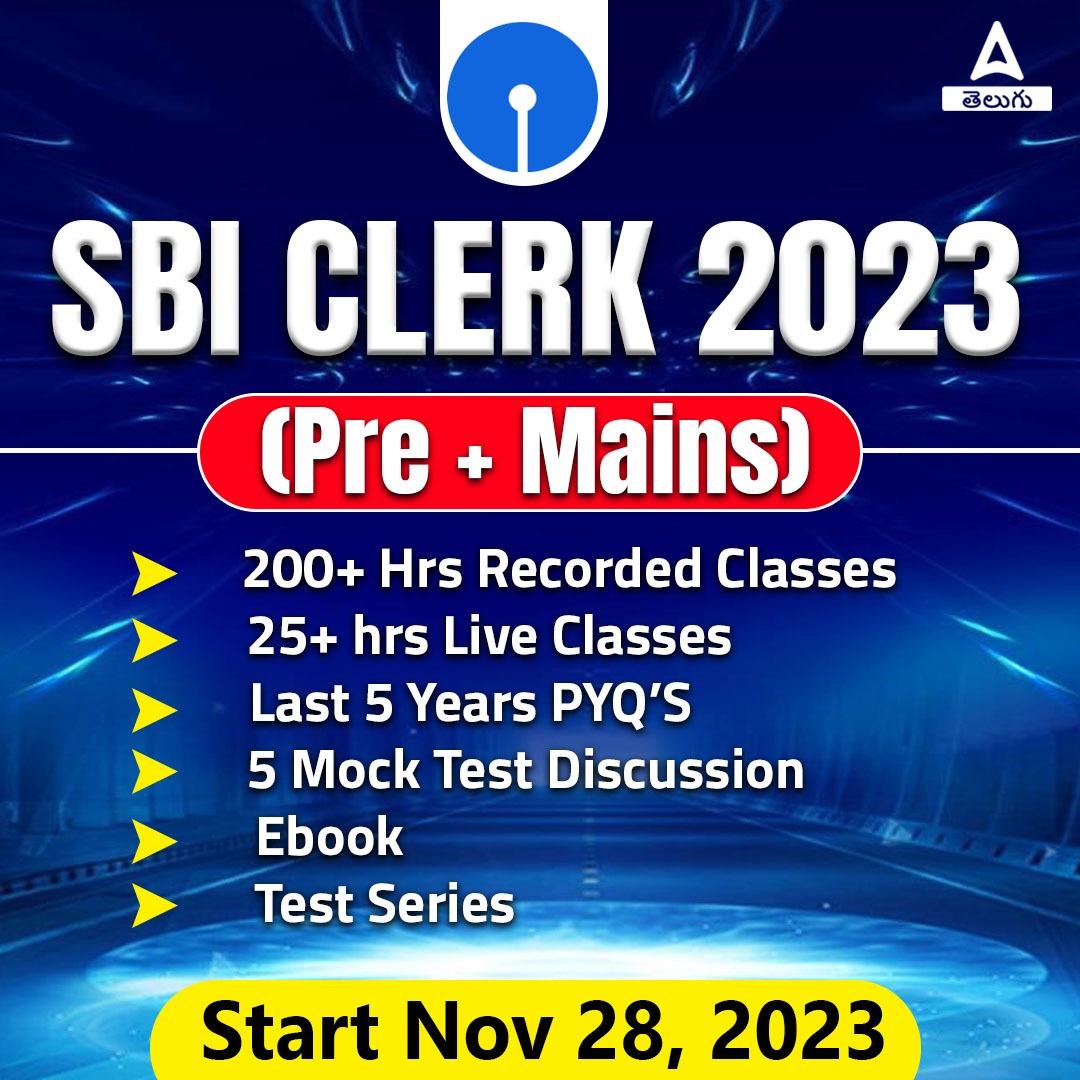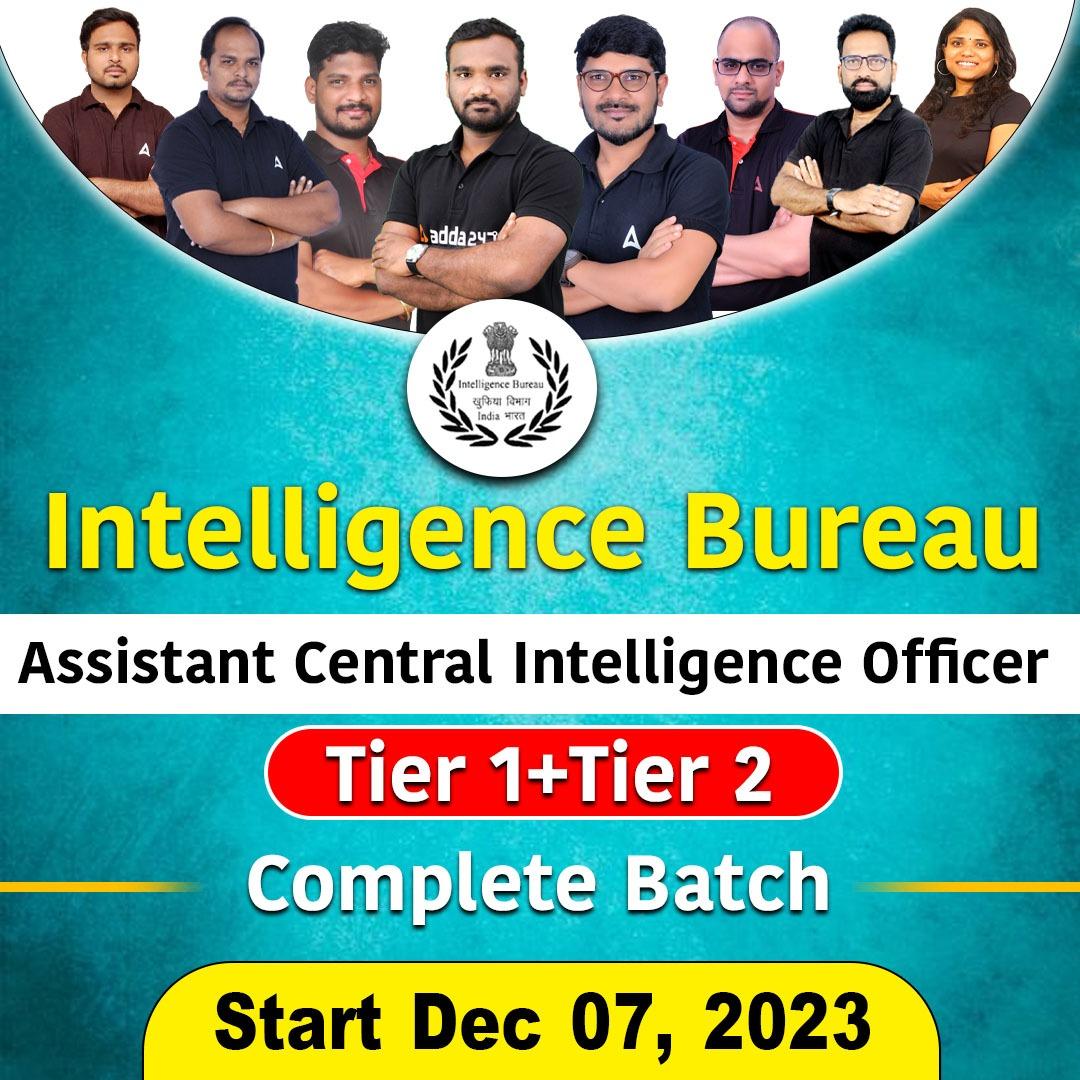TSPSC జూనియర్ లెక్చరర్ సిలబస్
TSPSC జూనియర్ లెక్చరర్ సిలబస్ పేపర్ I మరియు పేపర్ II కోసం సిలబస్గా విభజించబడింది. పేపర్ I జనరల్ స్టడీస్ మరియు జనరల్ ఎబిలిటీస్ నుండి అంశాలను కలిగి ఉండగా, పేపర్ II సంబంధిత సబ్జెక్ట్ (పోస్ట్ గ్రాడ్యుయేట్ స్థాయి) సిలబస్ను కవర్ చేస్తుంది. ఈ పేజీలో, అభ్యర్థులు TSPSC జూనియర్ లెక్చరర్ సిలబస్ 2023ని మరియు సిలబస్ PDF అందించాము. TSPSC జూనియర్ లెక్చరర్ పరీక్ష CBRT పద్ధతిలో 12 సెప్టెంబర్ 2023 నుండి 3 అక్టోబర్ 2023 వరకు జరుగుతుంది. TSPSC జూనియర్ లెక్చరర్ పరీక్షకు సిద్ధం అవుతున్న అభ్యర్ధులు తమ ప్రిపరేషన్ ని మెరుగు పరచాలి. ఇక్కడ ఈ కథనంలో, మేము TSPSC జూనియర్ లెక్చరర్ సిలబస్ & పరీక్షా సరళి 2023 వివరాలను అందిస్తున్నాము. మరిన్ని వివరాల కోసం కథనాన్ని పూర్తిగా చదవండి.

TSPSC జూనియర్ లెక్చరర్ సిలబస్ అవలోకనం
TSPSC జూనియర్ లెక్చరర్ పరీక్షకు సిద్ధం అవుతున్న అభ్యర్ధులు TSPSC జూనియర్ లెక్చరర్ సిలబస్ మరియు పరీక్షా సరళి కోసం తెలుసుకోవాలి. TSPSC జూనియర్ లెక్చరర్ సిలబస్ అవలోకనం దిగువ పట్టికలో అందించాము.
|
TSPSC జూనియర్ లెక్చరర్ సిలబస్ 2023 అవలోకనం |
|
| సంస్థ | తెలంగాణ రాష్ట్ర పబ్లిక్ సర్వీస్ కమిషన్ |
| పోస్ట్ | TSPSC జూనియర్ లెక్చరర్ |
| TSPSC జూనియర్ లెక్చరర్ ఖాళీలు 2023 | 1392 |
| TSPSC జూనియర్ లెక్చరర్ పరీక్ష తేదీ 2023 | 12 సెప్టెంబర్ 2023 నుండి 3 అక్టోబర్ 2023 వరకు |
| వర్గం | సిలబస్ |
| ఎంపిక పక్రియ | వ్రాత పరీక్షా మరియు డాక్యుమెంట్ వెరీఫికేషన్ |
| TSPSC జూనియర్ లెక్చరర్ పరీక్ష విధానం | CBRT |
| జీతం | రూ. 54220-1,33,630/- |
| ఉద్యోగ ప్రదేశం | తెలంగాణ |
| అధికారిక వెబ్సైట్ | tspsc.gov.in |
TSPSC జూనియర్ లెక్చరర్ పరీక్షా సరళి 2023
TSPSC జూనియర్ లెక్చరర్ పరీక్షలో రెండు పేపర్లు ఉంటాయి.
ఒక పేపర్కు 150 మార్కులు ఉంటాయి.
మరో పేపర్ 300 మార్కులకు ఉంటుంది.
ఒక్కో పేపర్ వ్యవధి 150 నిమిషాలు.
| పేపర్స్ | సబ్జెక్ట్ | ప్రశ్నల సంఖ్య | మార్కులు | వ్యవధి |
| పేపర్ I | జనరల్ స్టడీస్ మరియు జనరల్ ఎబిలిటీస్ | 150 | 150 | 150 నిముషాలు |
| పేపర్ -II | సంబంధిత సబ్జెక్ట్స్ | 150 | 300 | 150 నిముషాలు |
| మొత్తం | 300 | 450 | 300 నిముషాలు | |
TSPSC జూనియర్ లెక్చరర్ సిలబస్ 2023
పేపర్ 1 సిలబస్- జనరల్ స్టడీస్ మరియు జనరల్ ఎబిలిటీస్
1. Current Affairs – Regional, National and International.
2. International relations and events.
3. General Science; India’s Achievements in Science and Technology
4. Environmental issues; Disaster Management- Prevention and Mitigation Strategies.
5. Economic and Social Development of India and Telangana.
6. Physical, Social and Economic Geography of India.
7. Physical, Social and Economic Geography and Demography of Telangana.
8. Socio-economic, political and cultural history of modern India with special focus on
Indian National Movement.
9. Special focus on socio-economic, political and cultural history of Telangana Telangana state movement and formation of Telangana state.
10. Constitution of India; Indian Political System; Governance and Public Policy.
11. Social exclusion; Rights issues and policies like gender, caste, tribe, disability etc.
12. Society, Culture, Heritage, Arts and Literature of Telangana.
13. Telangana State Policies.
14. Logical Reasoning; Analytical ability and data interpretation.
15. Basic English. (10th Standard)
పేపర్ – II: సంబంధిత సబ్జెక్ట్ సిలబస్
1. ARABIC (PG LEVEL)
- Grammar
i. Syntax
ii. Morphology - History of Arabic Literature
i. History of Classical Arabic Literature
ii. History of Modern Arabic Literature - Eminent Personalities of India
i. Shaikh Abdul Haq Muhaddis Dehelvi
ii. Shaik Shah Waliullah Muhaddis Dehelvi
iii. Shaikh Allama Anwar Ullah Farooqui
iv. Shaik Fazlul Haq Khairabadi
v. Shaik Ghulam Ali Azaad Bilgrami - Translation (unseen passages):
i. From English to Arabic
ii. From Arabic to English
2. BOTANY (PG LEVEL)
- Phycology, Mycology, Bacteria and Viruses
- Bryophyta, Pteridophyta and Gymnosperms
- Taxonomy of Angiosperms
- Plant Anatomy and Embryology
- Plant Resource Utilization and Conservation
- Plant Ecology
- Cell Biology
- Cytogenetics
- Plant Physiology
- Biotechnology and Genetic Engineering
3. CHEMISTRY (PG LEVEL)
INORGANIC CHEMISTRY
- Atomic structure and chemical bonding
- Chemistry of main group (I to VII & Nobel gases) elements.
- Chemistry of transition elements and inner transition elements.
- General principles of metallurgy
- Coordination Chemistry
- Stability of metal complexes
- Reaction mechanism of metal complexes
- Metal carbonyls, Nitrosyls and Metallocenes – Structure and bonding.
- Bio-inorganic chemistry
- Analytical chemistry
PHYSICAL CHEMISTRY
- Solutions and colligative properties
- Acids and bases
- Thermodynamics
- Electrochemistry
- Quantum chemistry
- Chemical kinetics
- Photochemistry
- Solid state chemistry
ORGANIC CHEMISTRY
- IUPAC nomenclature of organic molecules. Isomerism – classification of isomers.
- Classification, preparations and properties of alkane, alkenes, alkynes, cyclo
alkanes, aromatic hydrocarbons, halogen compounds, hydroxy compounds,
carbonyl compounds, carboxylic acids and its derivatives. - Stereo chemistry
- Introduction to conformational isomerism, Klyne
- Nature of bonding in organic molecules and aromaticity
- Reactive intermediate
- Organic reaction mechanism
- Oxidation
- Reductions
- Heterocyclic chemistry
- Alkaloids and Terpenoids
- Organic photochemistry
- Pericyclic reactions
- Basic principles, concepts of UV, IR, H1NMR, C13NMR and Mass spectroscopic
methods – structure determination of organic compounds by UV, IR, H1NMR, C13NMR
and Mass spectroscopic methods. - Green chemistry
4. CIVICS (PG LEVEL)
- State and Nation States
- Concepts and Ideologies
- Democracy
- Indian Constitution
- Union Govt
- Constitutional and Other Bodies
- Local Bodies
- Judiciary
- Electoral System and Election Commission in India
- India and the World
5. COMMERCE (PG LEVEL)
- Financial Management
- Financial and Management Accounting
- Cost Accounting and Control
- Managerial Economics
- Organization Theory and Behaviour
- Marketing Management
- Quantitative Techniques
6. ECONOMICS (PG LEVEL)
- Micro Economics
- Macro Economics
- Public Finance
- International Economics
- Economics of Development and Growth
- Indian Economy
- Telangana Economy
- Quantitative Methods for Economic Analysis
- Banking and Economics of Infrastructure
- Economics of Environment
7. ENGLISH (PG LEVEL)
- Genres, Movements, Schools, Concepts.
- Writers and Texts
- English Language Teaching
1. ELT in India
2. Methods and Approaches
3. Teaching of Language Skills
4. Testing and Evaluation
5. Phonetics and Phonology - Literary comprehension
8. FRENCH (PG LEVEL)
- French Literature and literary movements
- Francophone Literatures
- French and Francophone Cultures and Civilizations
- Translation
- Linguistics
- Didactics
- French Language: Grammatical and Written Competence
9. HINDI (PG LEVEL)
- I. Study of the following ten authors and poets:
1. Kabir
2. Tulsidas
3. Bihari
4. Surdas
5. Acharya Ramachandra Shukla
6. Premchand
7. Prasad
8. Pant
9. Nirala
10. Dinakar - II. Appreciation of the popular couplets of Tulsi, Kabir, Rahim, Vrinda etc., and a few
lines from modern poets of Prasad, Pant etc. - III.
1. Details Study of “Hindi Sahitya ka Itihas”
(1. Adikaal, 2. Bhaktikaal, 3. Ritikaal, 4. Aadhunikkaal)
2. Origin and development of prominent literary genres in modern Hindi, eg Novel,
Short Story, Drama, Criticism . - IV. The study of the following eight trends of the history of Hindi Literature.
1. Gyan Margi Shakha
2. Prem Margi Shakha
3. Ram Bhakti Shakha
4. Krishna Bhakti Shakha
5. Riti kavya
6. Chayavada
7. Pragativada
8. Nai Kavita - V. History of various aspects of the Hindi Language, eg:
1. Grammatical and lexical features of Apabhransa, Avahatta, and early Hindi.
2. Evolution of Khari Boli Hindi as a literary language during the 19th Century.
3. Development of Hindi as Rastra Bhasha during the freedom struggle and as
an official language of the Indian Union since Independence.
4. Major Dialects of Hindi and their inter-relationship
5. Functional and significant grammatical features of standard Hindi
6. Origin and development of Devanagari script and its role in the standardization of
Hindi language.
10. HISTORY (PG LEVEL)
Ancient India
- Definition of History, Scope, Nature, Sources.
- Pre and Proto History
- Harappan Civilization
- Iron Age – Aryan Migrations – Second Urbanization.
- India in 6th Century BC;
- Mauryan Age
- Satavahana Age
- Gupta Age
- India in the Seventh Century AD
Medieval India
- India between 650 AD to 1200 AD
- Age of Delhi Sultanate 1206 AD -1526 AD
- Age of Vijayanagara
- Moghul Age (1526-1707)
Modern India
- Establishment of British Power in India
- British paramountcy in India
- Socio-Religious Reforms Movements
- 1857 Revolt; causes, results and significance.
- Rise and Growth of Indian National Movement
Modern World
- Industrial Revolution
- American War of Independence
- French Revolution
- National Liberation Movements in Italy and Germany in the 19th Century
- World War-I – 6. The Russian Revolution of 1917 The world between the Two Worlds
- Wars Italy, Turkey under Mustafa Kamal Pasha.
- Developments in China 1911-1949
- World War-II
History of Telangana
- Pre History
- Pre-Satavahana, Satavahana, Post-Satavahana
- Telangana from 7th Century to 11th Century
- Age of Kakatiya’s Padma Nayaka’s and Musunoori.
- Qutubshahis
- Asafjahis
11. MATHEMATICS (PG LEVEL)
- Real Analysis
- Metric Spaces
- Elementary Number Theory
- Group Theory
- Ring Theory
- Vector Spaces
- Theory of Matrices
- Complex Analysis
- Ordinary Differential Equations
- Partial Differential Equations
- Solid Geometry
12. Physics (PG LEVEL)
- Mathematical Methods of Physics
- Classical Mechanics
- Electromagnetic Theory
- Quantum mechanics
- Thermodynamics and statistical physics
- Electronics
- Atomic & Molecular Physics
- Condensed Matter Physics
- Nuclear and Particle Physics
13. SANSKRIT (PG LEVEL)
- Vedic Literature
History of Vedic Literature
Vedangas - Darasana
Grammar, Linguistics, Prosody
1) Grammar:
i. Siddhantakanmdi
Mahabhasya (Paspasahnika)
2) Linguistics:
i. Paniniyasiksa
ii. Definition and types of languages
iii. Niruktam,
iv. Purana and Itihasa.
v. Kavyasastra
vi. Poetry, Prose, Dramas and History of Sanskrit Literature
vii. (i) Kautilya’s Arthasastra (First ten Adikaras)
(ii) Manusmriti (I, II, and VII Adhyayas)
(iii) Yajnavalkyasmriti (Vyavaharakanda only)
(iv) Susritasamhita (Sutrasthana and Ojah Kshayah)
viii. General Translation
14. TELUGU (PG LEVEL)
- Study of Traditional Literary Poets – Period – Works
- Vemana Philosophy A Contemporary Observation Perspective – Impact of Vemana Poetry on Society
- Study of Telugu Grammar and Moonlight
- Study of Linguistics – Linguistics, Semi-evolution – Modern Period (From Scriptural Language to Literary Language)
15. URDU (PG LEVEL)
- Origin & development of urdu language
- Deccaniyat
- Development of different forms of literature
- Literary criticism
- Different literary movements
- Urdu journalism, translation & mass – media, print and electronic.
16. ZOOLOGY (PG LEVEL)
- General Concepts
- Non-Chordata:
- Chordata
- Cell Biology
- Genetics
- System and Cell Physiology
- Evolution
- Developmental Biology
- Histology
- Ecology
- Immunology
TSPSC జూనియర్ లెక్చరర్ సిలబస్ pdf
TSPSC జూనియర్ లెక్చరర్ల పోస్ట్ కోసం దరఖాస్తు చేసుకున్న అభ్యర్థులు TSPSC జూనియర్ లెక్చరర్ కోసం పరీక్ష CBRT పద్ధతిలో 12 సెప్టెంబర్ 2023 నుండి 3 అక్టోబర్ 2023 వరకు జరుగుతుంది. TSPSC జూనియర్ లెక్చరర్ల పరీక్షకు హాజరు కావాలనుకునే అభ్యర్ధులు TSPSC జూనియర్ లెక్చరర్ల సిలబస్ పై అవగాహన కలిగి ఉండాలి. తద్వారా పరీక్షలో మంచి మార్కులు సాధించడానికి అవగాహన కలిగి ఉంటుంది. TSPSC జూనియర్ లెక్చరర్ల సిలబస్ PDF దిగువన అందించాము.
TSPSC Junior Lecturer Syllabus pdf
TSPSC జూనియర్ లెక్చరర్ ఆర్టికల్స్
| TSPSC జూనియర్ లెక్చరర్ సిలబస్ |
| TSPSC జూనియర్ లెక్చరర్ నోటిఫికేషన్ |
| TSPSC జూనియర్ లెక్చరర్ పరీక్షా తేదీ |
| TSPSC జూనియర్ లెక్చరర్ మునుపటి సంవత్సరం ప్రశ్న పత్రాలు |
| TSPSC జూనియర్ లెక్చరర్ హాల్ టికెట్ 2023 |
| మరింత చదవండి: |
|
| తాజా ఉద్యోగ ప్రకటనలు | ఇక్కడ క్లిక్ చేయండి |
| ఉచిత స్టడీ మెటీరియల్ (APPSC, TSPSC) | ఇక్కడ క్లిక్ చేయండి |
| ఉచిత మాక్ టెస్టులు | ఇక్కడ క్లిక్ చేయండి |

